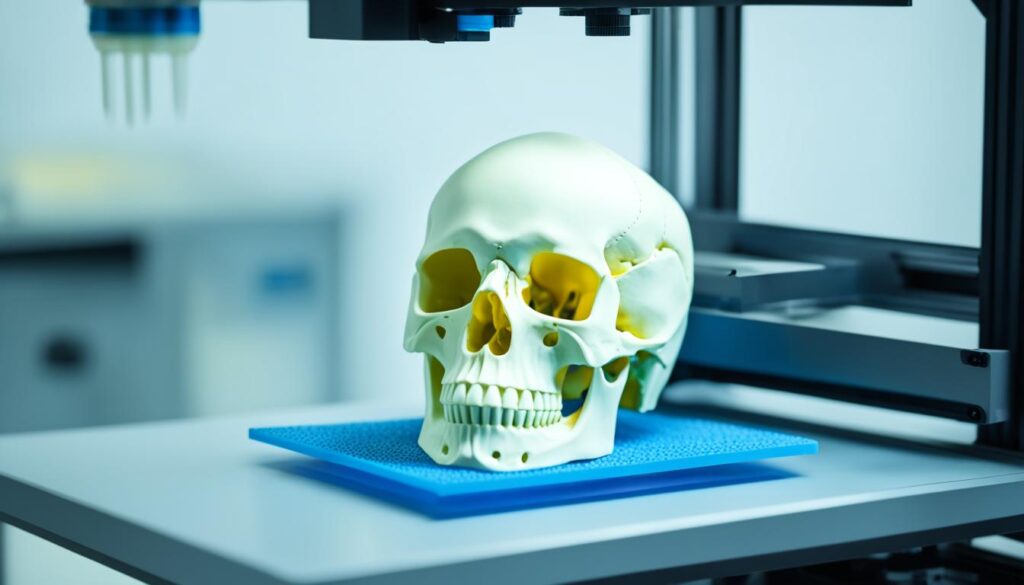3D Printing Technology : 3D printing, also known as additive manufacturing, is a revolutionary technology that allows the creation of physical objects from 3D digital models. It works by adding layers of material on top of each other until the object is fully formed. This technology has its roots in the 1970s and has since evolved to become a widely used method for rapid prototyping and production.
Key Takeaways:
- 3D printing enables the creation of physical objects from 3D digital models using additive manufacturing.
- The technology has its origins in the 1970s and has evolved for rapid prototyping and production.
- It works by adding layers of material on top of each other until the object is fully formed.
- 3D printing offers significant advantages such as cost-effectiveness and customization.
- The future of 3D printing holds promising advancements and applications.
A Brief History of 3D Printing
The concept of 3D printing, also known as additive manufacturing, was first developed in the 1970s. However, it wasn’t until the 1980s that early equipment and materials were developed to bring this revolutionary technology to life. One notable figure in the history of 3D printing is Hideo Kodama, who filed a patent for the technology during this time, although it was not commercialized.
Also Read : Exploring Blockchain Technology Innovations & Uses
In the 1990s, 3D printing started to gain attention from various industries. Significant advancements were made, showcasing the true potential of this technology. For example, researchers successfully printed functional human organs, opening up possibilities for transplants and medical breakthroughs.
Also Read : Essential Smart Home Devices for Easy Living
As we entered the 2000s, additive manufacturing began to gain widespread popularity. The technology’s ability to enable rapid prototyping became a game-changer for designers and engineers, allowing them to quickly iterate on their ideas and bring them to life.
Also Read : Top Software Development Tools & Solutions 2024
Throughout its history, 3D printing has continued to evolve, pushing the boundaries of what is possible in manufacturing and production. Today, this technology has become an essential tool for industries ranging from aerospace to healthcare, revolutionizing the way we design and create objects.
Let’s explore the various processes and applications of 3D printing in the following sections.
Also Read : Quality Custom Mobile App Development Services
How Does 3D Printing Work?
3D printing is a fascinating technology that operates through a layer-by-layer printing process, enabling the creation of complex and customized objects. Several different manufacturing processes are employed in 3D printing, each with its unique characteristics and capabilities.
Also Read : Protect Assets with Business Umbrella Insurance
Fused Deposition Modeling (FDM)
FDM is one of the most commonly used 3D printing processes. It involves the deposition of layers of melted plastic to build the object gradually. A plastic filament is fed into the printer, and the filament is heated to its melting point. The printer then moves along the X, Y, and Z axes, depositing the melted plastic in precise patterns to form each layer of the object.
Selective Laser Sintering (SLS)
SLS utilizes a laser to selectively melt powdered plastic or metal materials. The printer scans each layer of the object using the laser, which fuses the small particles together to form a solid structure. This process allows for the creation of objects with intricate geometries and excellent mechanical properties.
Stereolithography (SLA) and Digital Light Processing (DLP)
SLA and DLP technologies solidify liquid resin into the desired shape using light. In SLA, a laser selectively solidifies the resin layer by layer, while in DLP, a projector shines light onto the entire layer, solidifying it all at once. These processes produce high-resolution prints with smooth surfaces, making them ideal for creating detailed models and prototypes.
These are just a few examples of the various 3D printing processes available. Each process has its own strengths and is suited for different applications, ranging from rapid prototyping to industrial production.
Understanding the different 3D printing processes is key to harnessing the full potential of this remarkable technology, and it opens up a world of possibilities for customization and innovation.
Next, we will explore the different types of 3D printing technologies and how they impact the creation of objects.
Types of 3D Printing Technologies
When it comes to 3D printing, there are several technologies available, each with its own unique capabilities and applications. Let’s explore some of the most widely used 3D printing technologies: Fused Deposition Modeling (FDM), Selective Laser Sintering (SLS), Stereolithography (SLA), and Digital Light Processing (DLP).
Fused Deposition Modeling (FDM)
FDM is a popular 3D printing technology that creates objects by layering melted thermoplastic material. The printer extrudes the material through a small nozzle, which moves in a controlled manner to deposit the material in precise patterns, layer by layer. FDM is commonly used for basic prototyping and is known for its simplicity and cost-effectiveness.
Selective Laser Sintering (SLS)
SLS is a laser-based 3D printing technology that uses powdered materials, such as plastics or metals. The printer scans a laser across a bed of powdered material, selectively melting it to create each layer of the object. SLS is ideal for producing complex geometries and functional parts with high accuracy and durability.
Stereolithography (SLA)
SLA is a 3D printing technology that uses a photochemical process to solidify liquid resin into solid objects. A laser or other light source is used to selectively expose the liquid resin to cure it and form each layer of the object. SLA printing offers high resolution and smooth surface finishes, making it suitable for creating detailed models and prototypes.
Digital Light Processing (DLP)
DLP is a similar technology to SLA, but instead of using a laser, it utilizes a digital light projector to cure the liquid resin. The projector displays the entire layer of the object onto the resin, curing it all at once. DLP printing also provides high resolution and smooth finishes, and it is often faster compared to SLA.
Each of these 3D printing technologies has its own strengths and limitations, making them suitable for different applications. Here is a summary of their key characteristics:
| Technology | Advantages | Limitations |
|---|---|---|
| FDM | Low cost, easy to use, suitable for basic prototyping | Limited resolution, visible layer lines |
| SLS | High accuracy, complex geometries, functional parts | Higher cost, limited material selection |
| SLA | High resolution, smooth surface finish, detailed models | Relatively slower printing speed, limited build size |
| DLP | High resolution, fast printing speed | Relatively slower printing speed, limited build size |
Understanding the different 3D printing technologies can help you choose the right one for your specific requirements and desired outcomes. Whether you need quick and affordable prototyping or intricate and detailed models, there is a 3D printing technology that can meet your needs.
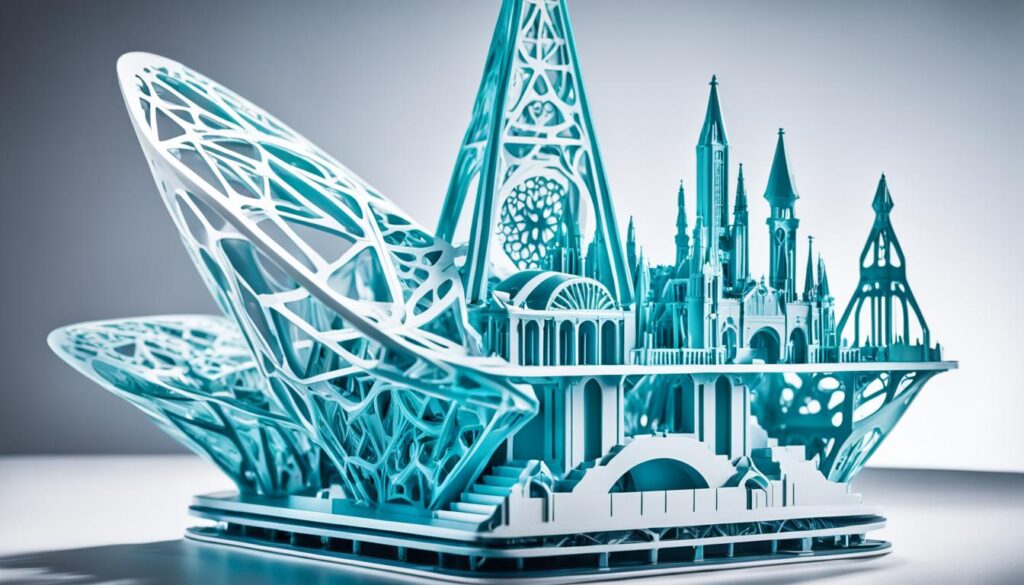
Having discussed the various 3D printing technologies, let’s now delve into the materials commonly used in 3D printing in the following section.
Materials Used in 3D Printing
3D printing materials play a crucial role in the additive manufacturing process. The choice of material can significantly impact the properties and characteristics of the printed object. From thermoplastics to resins, let’s explore the various materials used in 3D printing.
Thermoplastics
Thermoplastics are the most commonly used materials in 3D printing, particularly in the Fused Deposition Modeling (FDM) process. These materials have excellent physical properties and are available in a wide range of colors. Two popular thermoplastics used in FDM printing are:
- ABS (Acrylonitrile Butadiene Styrene): Known for its strength and durability, ABS is widely used for creating functional prototypes and end-use parts in industries like automotive and electronics.
- PLA (Polylactic Acid): PLA is a biodegradable thermoplastic derived from renewable sources like corn starch or sugarcane. It is commonly used for producing concept models and low-stress applications.
Resins
Resins are popular materials for vat polymerization processes like Stereolithography (SLA) and Digital Light Processing (DLP). These materials offer high resolution and produce objects with smooth finishes. Two common types of resins used in 3D printing are:
- Standard Resins: Standard resins are versatile and come in different colors. They are used for general-purpose applications and can be easily post-processed for better surface finishes.
- Specialized Resins: Specialized resins are formulated to meet specific requirements, such as high temperature resistance, flexibility, and biocompatibility. These resins are commonly used in industries like healthcare and engineering.
Other Materials
Aside from thermoplastics and resins, other materials are also used in 3D printing, depending on the technology employed:
- Powdered Plastics: Selective Laser Sintering (SLS) utilizes powdered plastics, such as polyamide, to create objects with intricate geometries.
- Metal Powders: Metal 3D printing processes, like Direct Metal Laser Sintering (DMLS), utilize metal powders, including titanium and aluminum alloys, to produce complex metal parts.
Choosing the right material for a 3D printing project depends on factors like the desired properties, application, and the 3D printing technology being used.

Applications of 3D Printing
3D printing technology has revolutionized various industries by offering a wide range of applications. Its versatility and capabilities have made it a valuable tool in several fields, including rapid prototyping, industrial production, and medical applications.

Rapid Prototyping
Rapid prototyping, a crucial step in the design and development process, has been greatly enhanced by 3D printing. Designers and engineers can quickly transform their ideas into physical objects by printing multiple prototypes in a short time. This allows for rapid iterations and testing, leading to faster product development and improved designs.
Industrial Production
3D printing has also found significant applications in industrial production. It enables small batch manufacturing, where customized products can be produced economically and efficiently. This flexibility eliminates the need for expensive tooling and molds, reducing production costs and lead times. Moreover, 3D printing facilitates the creation of complex geometries and intricate designs that would be challenging to manufacture using traditional methods.
Medical Applications
One of the most exciting and promising areas where 3D printing has made a significant impact is in the medical field. Medical professionals are leveraging this technology to produce customized medical implants, prosthetics, and anatomical models. By utilizing patient-specific data, 3D printing allows for personalized medical solutions that enhance patient outcomes and surgical precision. It has also enabled advancements in bioprinting, a process of fabricating living tissues and organs, holding great potential for regenerative medicine and transplantation.
Table: Applications of 3D Printing
| Rapid Prototyping | Industrial Production | Medical Applications |
|---|---|---|
| Enables quick iterations and testing of designs | Enables small batch manufacturing and customization | Allows for personalized medical implants and prosthetics |
| Accelerates product development and design optimization | Reduces production costs and lead times | Potential for bioprinting and regenerative medicine |
| Facilitates faster time-to-market for new products | Enables the creation of complex geometries | Enhances surgical precision and patient outcomes |
Advantages of 3D Printing
3D printing offers numerous advantages that make it an attractive technology for various industries. From rapid prototyping to customization and cost-effectiveness, this innovative manufacturing process has transformed the way objects are designed and produced.
Rapid Prototyping and Design Iterations
One of the key strengths of 3D printing is its ability to rapidly produce prototypes. Traditional manufacturing methods can be time-consuming and costly when it comes to creating prototypes. With 3D printing, designers can quickly iterate on their designs, making improvements and adjustments in a matter of hours or days rather than weeks or months. This accelerated prototyping process allows for faster product development cycles and reduces time to market.
Customization and Personalization
Unlike mass production techniques, 3D printing enables customization and personalization on a large scale. Each object can be tailored to meet specific requirements, whether it’s a customized phone case, a personalized medical implant, or a unique piece of jewelry. This level of customization offers endless possibilities for individuals and businesses to create products that cater to individual tastes and needs.
Cost-Effectiveness for Small Production Runs
3D printing can often be more cost-effective, especially for small production runs. Traditional manufacturing processes often require expensive molds, tools, and setup costs, making them less feasible for small-scale production. In contrast, 3D printing eliminates the need for costly tooling, allowing for more cost-effective production of small batches of products. This cost advantage is particularly beneficial for startups, niche markets, and custom manufacturing.
Reduced Material Waste and Complex Geometries
Another advantage of 3D printing is the reduced material waste compared to traditional manufacturing processes. Conventional methods often involve subtractive manufacturing, where excess material is removed to create the final object. 3D printing, instead, uses additive manufacturing, which adds material only where it’s needed, minimizing waste. Additionally, 3D printing allows for the creation of complex geometries that would be challenging or impossible to achieve with traditional manufacturing methods. This opens up new design possibilities, enhances functionality, and promotes innovation.
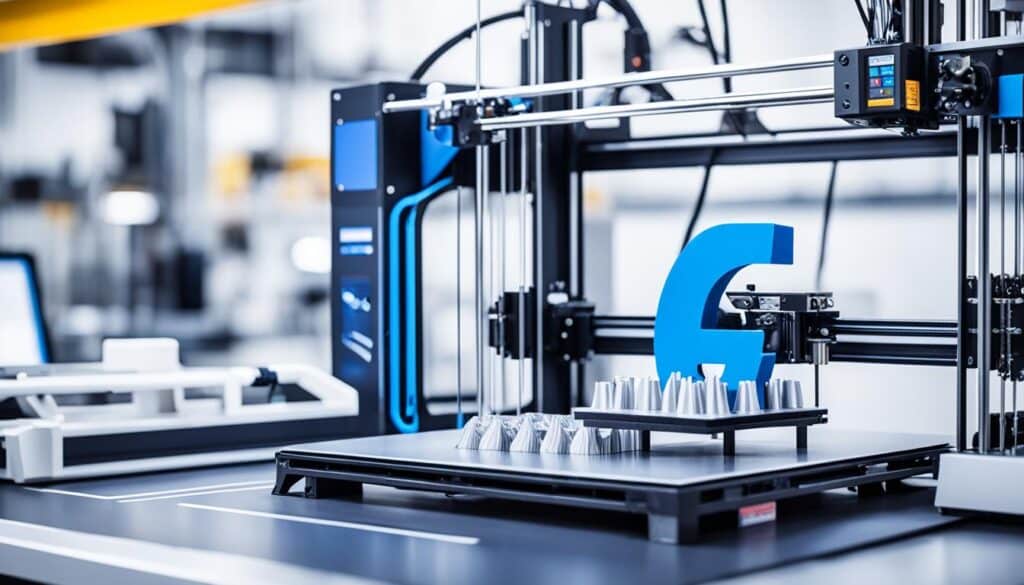
Overall, the advantages of 3D printing in terms of rapid prototyping, customization, and cost-effectiveness make it a compelling technology for various industries. As the technology continues to advance, we can expect even more remarkable applications and benefits to emerge.
Limitations of 3D Printing
While 3D printing technology offers numerous advantages, it is important to consider its limitations. Understanding these limitations will help set realistic expectations and ensure that the technology is used effectively.
1. Resolution
The resolution of 3D printed objects may not match that of objects produced through other manufacturing processes. Due to the layer-by-layer printing approach, the surface finish of 3D printed objects can be rough, with visible layer lines. This limitation can affect the aesthetic appeal and precision of intricate designs.
2. Print Size
3D printers have size restrictions when it comes to the objects they can produce. Large-scale prints may require specialized equipment or multiple print jobs that need to be assembled later. This limitation can impact the production of large and complex objects, especially in industries that require voluminous prototypes or parts.
3. Material Limitations
The choice of materials for 3D printing is continually expanding; however, certain materials may not be suitable for the technology. Each 3D printing technology has its own set of compatible materials, and not all materials may be readily available or affordable. Depending on the intended application, the required material properties may not be achievable through 3D printing alone.
| Limitation | Description |
|---|---|
| Resolution | The layer-by-layer printing approach can result in visible layer lines and rough surface finish, affecting the aesthetic appeal and precision of intricate designs. |
| Print Size | 3D printers have size restrictions, making it challenging to produce large and complex objects in a single print. |
| Material Limitations | The range of available materials may be limited, with certain materials not suitable for 3D printing due to compatibility issues or cost constraints. |
Despite these limitations, 3D printing continues to revolutionize manufacturing and offer innovative solutions in various industries. By understanding and working within the constraints of resolution, print size, and material limitations, professionals can harness the full potential of 3D printing technology.
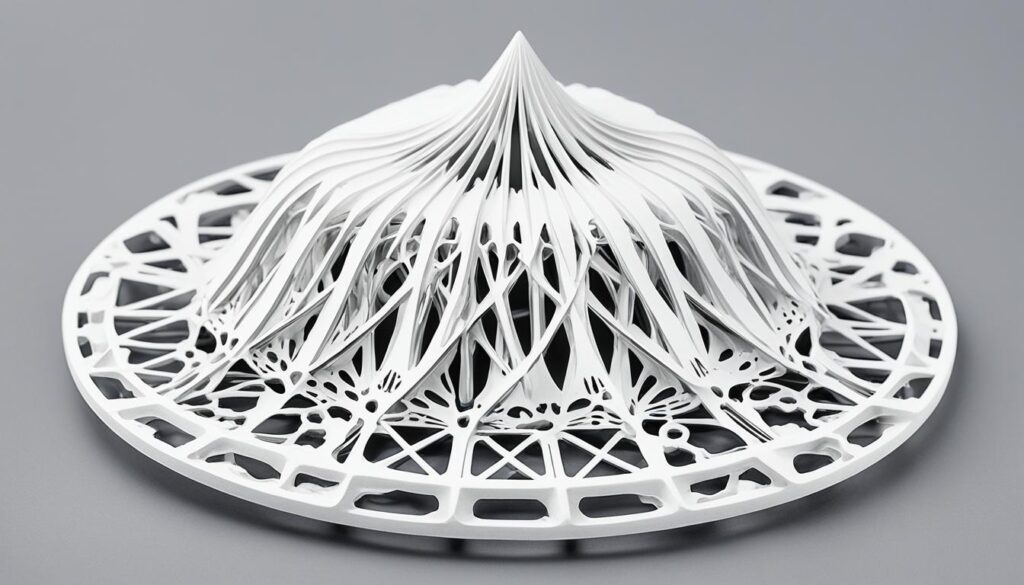
“While 3D printing has its limitations, it is crucial to remember that every technology has its specific characteristics and constraints. By embracing these limitations, researchers and engineers can push the boundaries of what is possible and unlock new opportunities for innovation.” – Dr. Jane Mitchell, Materials Scientist
Emerging Trends in 3D Printing
As 3D printing technology continues to advance, several emerging trends are shaping the future of this innovative field. These trends include:
Metal 3D Printing
Metal 3D printing is gaining traction in various industries, offering the ability to produce complex and intricate metal parts. This technology utilizes metal powders or filaments to create objects with exceptional strength and durability. With metal 3D printing, manufacturers can fabricate components with intricate geometries and intricate internal structures, paving the way for new possibilities in industries such as aerospace, automotive, and healthcare.
Bioprinting
Bioprinting is revolutionizing the healthcare industry by enabling the fabrication of functional human organs and tissues. This emerging trend combines 3D printing with biological materials, such as living cells and biomaterials, to create living structures that mimic the complexity of natural human organs. The potential applications of bioprinting include organ transplantation, drug testing, and personalized medicine, offering hope for improved patient care and medical advancements.
Multi-Material Printing
Multi-material printing allows for the production of objects with different materials and properties in a single print. With this technology, complex objects can be created by combining materials with different physical characteristics, such as rigid and flexible parts or conductive and insulating elements. Multi-material printing opens up new avenues for product design, enabling the fabrication of functional prototypes with diverse functionalities and unique combinations of materials. It has applications in industries ranging from electronics to consumer goods.
These emerging trends in 3D printing demonstrate the continuous evolution of this technology and its immense potential to revolutionize various industries. Metal 3D printing, bioprinting, and multi-material printing are paving the way for groundbreaking advancements and redefining the boundaries of design, manufacturing, and healthcare.
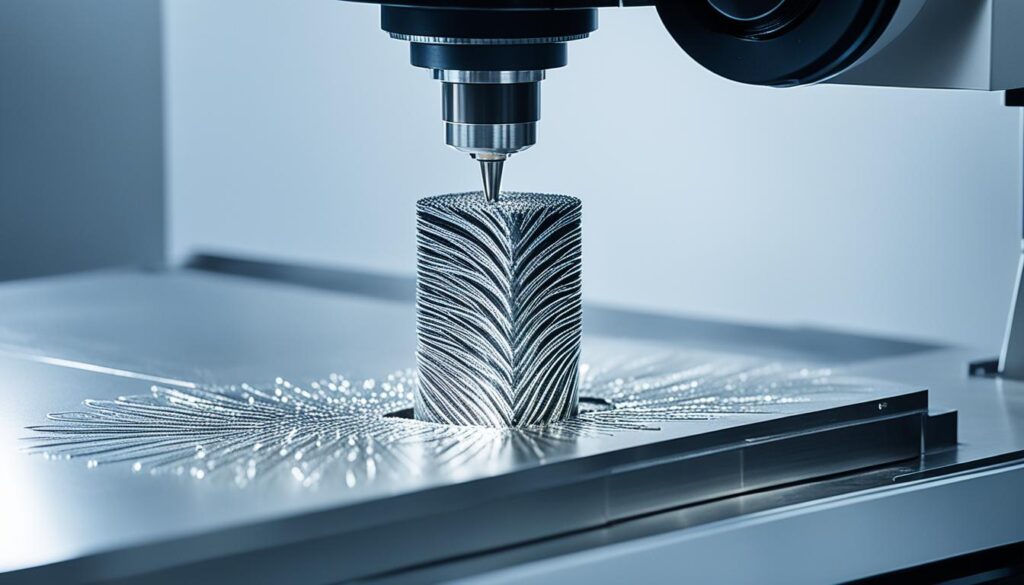
Choosing the Right 3D Printer
When it comes to selecting a 3D printer, there are several crucial factors to consider. The decision-making process should take into account the specific requirements of your project, including cost, features, and intended use.
For individuals or small-scale projects, desktop 3D printers are often the more affordable and suitable option. These compact machines offer a wide range of capabilities while still fitting comfortably on a desktop or workbench. With desktop 3D printers, you can bring your creative ideas to life without breaking the bank.
On the other hand, industrial-grade 3D printers are designed for professional use, providing advanced features and capabilities. These robust machines are commonly found in manufacturing facilities, engineering firms, and industries that require high-quality and precise prints. While industrial 3D printers come at a higher cost, they offer unparalleled performance and durability for demanding applications.
When evaluating 3D printers, it’s essential to assess the features they offer. Consider factors such as print quality, build volume, resolution, and material compatibility. The right 3D printer should meet your specific needs and deliver the required level of precision and detail.
Cost is an important consideration for any project. It’s crucial to define your budget and identify the price range that aligns with your financial constraints. Be sure to keep in mind not only the initial cost of the printer but also ongoing expenses such as maintenance, material costs, and any necessary upgrades.
By carefully evaluating the features, print quality, and budget, you can make an informed decision when choosing a 3D printer that perfectly suits your needs. Whether you opt for a desktop 3D printer for small-scale projects or an industrial 3D printer for professional applications, investing in the right machine will empower you to bring your ideas to life with precision and efficiency.
The Future of 3D Printing
The future of 3D printing holds promising advancements and applications. As the technology continues to evolve, we can expect increased adoption in various industries, including aerospace, healthcare, and automotive. Innovations such as faster printing speeds, larger print sizes, and new materials will continue to drive the growth of 3D printing and expand its possibilities.
Advancements in 3D printing technology are opening up a world of possibilities for industries across the board. The aerospace field, for example, is embracing 3D printing to create lightweight and complex components, leading to increased fuel efficiency and improved performance. In healthcare, 3D printing is revolutionizing areas such as prosthetics and customized medical implants.
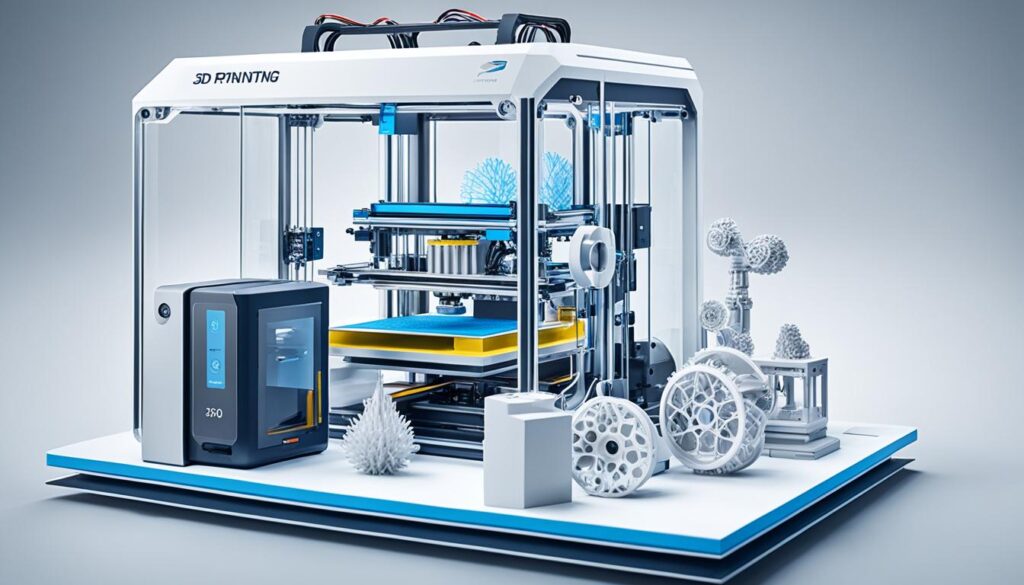
One of the most exciting areas of innovation is in the materials used for 3D printing. Researchers are constantly developing new materials that offer enhanced properties, such as increased strength, flexibility, and heat resistance. These advanced materials expand the range of applications for 3D printing and open up new possibilities in industries such as automotive and electronics.
Another area of focus is improving the speed and efficiency of 3D printing. Advancements in printing technologies, such as faster curing times for resin-based printers and larger build volumes, will enable faster production of complex objects and increase the scalability of 3D printing for large-scale manufacturing.
In addition to advancements in technology and materials, the future of 3D printing will see a wider range of applications. From architectural models to fashion accessories, the possibilities for 3D printing are virtually limitless. As the technology becomes more accessible and affordable, we can expect to see increased adoption by individuals and small businesses for personalized products and creative projects.
As 3D printing continues to mature, we can also anticipate the development of more sophisticated multi-material printing techniques. This will enable the creation of objects with different properties and functions within a single print. Imagine a car part that seamlessly transitions from a rigid structure to a flexible hinge in a single piece.
Also Read : Exploring Blockchain Technology Innovations & Uses
With these advancements and innovations on the horizon, the future of 3D printing looks incredibly promising. As the technology becomes more widely adopted and its capabilities continue to expand, we can expect to see even more groundbreaking applications across industries.
Conclusion
3D printing technology, also known as additive manufacturing, has revolutionized the manufacturing industry, ushering in new possibilities and opportunities across various sectors. With continuous advancements in materials, printing technologies, and applications, the future of 3D printing looks incredibly promising.
As the technology evolves, we can expect to witness even more innovative applications and widespread adoption of 3D printing. From rapid prototyping to industrial production, 3D printing is set to reshape the way we design, prototype, and manufacture in the years to come.
The future trends in 3D printing are poised to further enhance the industry’s capabilities. Metal 3D printing is gaining prominence, enabling the production of complex metal parts with high precision. Bioprinting offers incredible potential in the medical field, allowing for the creation of functional human organs and tissues. Additionally, multi-material printing is becoming increasingly popular, enabling the creation of objects with different materials and properties in a single print.
With these advancements and future trends, the impact of 3D printing technology on industries like aerospace, healthcare, and automotive is expected to be substantial. Faster printing speeds, larger print sizes, and the development of new materials will continue to drive innovation and expand the possibilities of 3D printing technology.
FAQ
Q: What is 3D printing technology?
A: 3D printing technology, also known as additive manufacturing, is a process of creating three-dimensional objects layer by layer using digital models.
Q: How does the 3D printing process work?
A: In the 3D printing process, the printer creates objects by depositing material layer by layer based on the digital design provided, typically using materials like plastic, metal, or resin.
Q: What are the types of 3D printers available?
A: There are various types of 3D printers, including Fused Filament Fabrication (FFF), Stereolithography (SLA), Selective Laser Sintering (SLS), and PolyJet, each utilizing different technologies for printing objects.
Q: What are the common applications of 3D printing technology?
A: 3D printing technology finds applications in various industries such as aerospace, automotive, healthcare, and engineering for prototyping, custom manufacturing, rapid production, and creating complex geometries.
Q: How are support structures used in 3D printing?
A: Support structures are temporary structures used in 3D printing to provide stability and prevent sagging during the printing process, especially for overhanging or complex geometries.
Q: What is the role of the build platform in 3D printing?
A: The build platform in 3D printing is the surface where the object is printed layer by layer. It serves as the foundation for the object being built and ensures proper adhesion of the layers.
Q: What are some common technologies used in the 3D printing industry?
A: Technologies such as UV light curing, laser sintering, and Fused Filament Fabrication (FFF) are commonly used in the 3D printing industry for producing high-quality printed parts.
Q: How does desktop 3D printing technology differ from industrial 3D printing?
A: Desktop 3D printing technology is more accessible and user-friendly for individual users and small businesses, while industrial 3D printing systems are larger in size, have higher precision, and are used for commercial production purposes.


